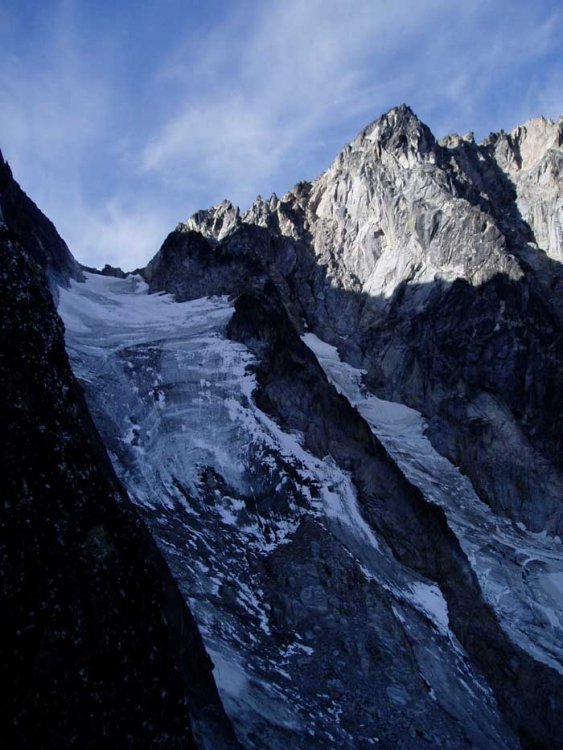-
Posts
4951 -
Joined
-
Last visited
-
Days Won
1
Everything posted by Alpinfox
-
You are correct. 51% of US voters are idiots apparently.
-
HOLY SHIT! I agree with S_H.
-
I'm bettin' he has a good enough sense of humor and a thick enough skin to not get run off by a mildly acerbic comment like: "OldManRock is a month late and $100 short, more like ripvanwinkle than oldmandrock. " but thanks for playing the role of Mr. Sensitivity NOLSe.
-
I just downloaded it. I think it's better than most mariah carey songs though.
-
A nice thing about the clear creek route is that with the predominant wind coming from the west, you may be somewhat sheltered from the full force of the wind. When I climbed the CC route (late June), we didn't see anyone else on our route and we were nice and cozy in wind shirts until we got to the summit block where we had to don our shells and insulating layers against the blasting wind. When we got to the summit there were lots and lots of shivering folks wearing gore-tex, balacalavas, big mittens etc that had come up the AG route. So, CC route = fewer people and potentially warmer conditions, but you have to drive further.
-
Looks cool. Take a "magic carpet ride" from spaceview all the way down to street level. $30. 7day trial version is free. They have 15m resolution for all of US w/ greater resolution of most major cities (Seattle, Spokane). I think the sideviews of terrain features will be a really nice tool for identifying peaks. Might even put Klenke out of business! I don't think it does USGS-style topo maps that can be used for navigation though.
-
Attached is a picture of the N. side of Colchuck in early September. I think the NBC is just out of the picture to the right?
-

Call or fax now to oppose Fee-Demo legislation
Alpinfox replied to peterclimb's topic in Access Issues
Hey Peter, Thanks for posting that. Link to email Bill Frist Link to email Ted Stevens Bill.Young@mail.house.gov tom.delay@tomdelay.com dhastert@mail.house.gov -
"Your eyes" aren't the only things you shouldn't touch after chopping Jalapenos.
-
I just hope they call off the game so I have less traffic driving to Tieton tomorrow. However, if the game happens, I think the cats is gonna claw them dawgs somthin' fierce. This year it's: vs.
-
I asked the same question of a BASE guy I met in the Index parking lot. He said: Get really good at the body positions of sky diving (from a plane). Hundreds of jumps. First BASE should be a bridge (greatest margin of safety) He said some other stuff too, but I forgot what it was. He gave me a card for $10 off my first jump at some skydiving place.
-
Yes, I DO actually own the whole set, I'm just having problems with disc #1. I've contacted Nat Geo's customer service department, but they haven't gotten back to me yet. A very generous person has offered to copy that disc for me, so hopefully that will fix the problem.
-
Anybody here have this program? I have a copy but my first disc (the one with the installer on it) seems to have gotten scratched or corrupted or something. Anybody out there willing to burn a copy of their disc #1 for me?
-
and one member to post:
-
Happy Birthday ye giver of fine chalk bags!
-
Other
-
My best is 977.3 Another game: Torpedo Joe *Edit: I fixed the link
-
Pandora likes syrup! Happy birthday!
-
Do you have any evidence to support that accusation? I've never heard that before. I've always heard that it was a consentual affair (as consentual as sex between a slave owner and his "property" can be anyway).
-
You're correct. I don't think wars can "go well". They are horrible things which is why this one shouldn't have been started in the first place.
-
"Make the pie higher" is a collection of actual George Bush quotes arranged by Richard Thompson, a Washington Post writer. (I know because I have that poem on my refrigerator) Squid IS a funny guy though.
-
I don't care if the guy believes in Tarot and worships a golden ass (I suspect he actually worships corporate profit and power), he's still a menace to my way of life, most of the world, and to future generations. However, his faith (born again chrisitian fundamentalism stupidity) gives him a sense of moral self-righteousness and divine mandate motivating him to "mold the US in god's image". It's clear that Bush wants to be remembered as a "transformational president" and imposing Christian - BORN-AGAIN-FUNDAMENTALIST-CHRISTIAN that is - morals on us is certainly part of his plan. Woe vs. Wade is certainly NOT unassailable. It only passed by a 5-4 margin in 1973. It is a VERY REAL possibility that it will be overturned in the near future. I can't believe a bunch of dipshit bible thumpers were able to get their man into the white house. I'm so embarrased.
-
The "Patriot" Act reduced civil liberty. Bush's administration has accelerated the rape of the environment and the pollution of the air, water, and land. He has destroyed our credibility around the globe as a progressive leader on the environment and international justice (Kyoto, ICC, etc) and has reinforced our image as an international bully which is why the US is despised by many people around the world. He has done nothing to make this country or this planet a better place to live. He has sent innocent Americans off to kill innocent Iraqis (and a few guilty ones) all the while sitting behind a desk and making millions of dollars for his corporate cronies. He is a fucking criminal and I hope he rots in hell. Soon. p.s. Did any of you actually go read that forum I posted the link to?
-
The protests at Shrub's first inaguration were pretty spirited (eggs were thrown! ). I wonder what will happen this time.... If I lived on the East Coast, I'd be stockin' up on eggs.


